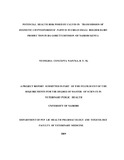| dc.description.abstract | Cryptosporidium parvum
, commonly referred to as Crypto, is a protozoan parasite (a one-
celled organ ism) that cause diarrhea in calves (as we ll as other animals) .This extracytoplasmic
organism invades enterocytes (cells that line the intestines) in the dista l small intestine and
large intestine.
The prevalence of C spp. in healthy asymptomatic calves was investigated in
ryptosporidium
urban small holder dairy farms in Dagoretti Division, Nairobi, Kenya on a population of 117
calves of 7-30 days old purposive ly selected from a population of 296 dairy farmers between
August 2006 and May, 2007.The detection of spp. was based on sodium
chloride floatat ion technique and modified acid fast stain (Modified Ziehl-Neelsen).
Additional ly, posit ive samples on Modified Ziehl-Neelsen (MZN) and 20% of the negative
samples were examined by Indirect F luorescence test (IFA) method as a comparative test. The
prevalence based on Mo dified Ziehl- Neilsen tests was 23 .4% (27/117). There was si gnificant
agreement (Kappa=0.45 ) between the MZN and IFA test. Isolates of were
examined via bidirectional DNA sequencing which revealed that they were
rynae,
which is considered to be no n zoonotic.
ABS TRACT
Using questionnaires, information regarding risk factors for cryptos poridiosis in both calves
and human was collected. The risk factors assessed with regard to cryptosporidiosis in calves
were management (housing and feeding) system , while with regard to human infection risk
factors included close association with calves, protecti ve clothing, washing of hands after
handling of manure and level of awareness about cryptosporidiosis were consid ered.
xiii
cryptosporidium
Cryptosporidium
Cryptosporidium
Ninety five percent (95%) of the respondents did not use any protective clothin g, 77.3% did
not wash hands after handling an imals and manure waste.
In a partic ipatory manner, farmers developed mitigation measures that would minimize risks
associated with handl ing of calves. Personal hyg iene was the s ingle most important mitigation
measure for reducing the risk of disease transmission. Other critical mitigation measures were
hygiene of calf-pens and milking areas.
There is evidence that dairy calves in Dagoretti have high level of cryptos poridiosis infect ion.
Further, crypto sporidiosis is not well known or understood within the dairy and close
neighboring commu nity in Dagoretti. Calf-borne needs to be typed in order to
find if it contain s an appreciab le proportion of the zoonotic stra in Therefore the
broad mitigat ion measures developed sh ould be ap plied to reduce the human health r isks | |

